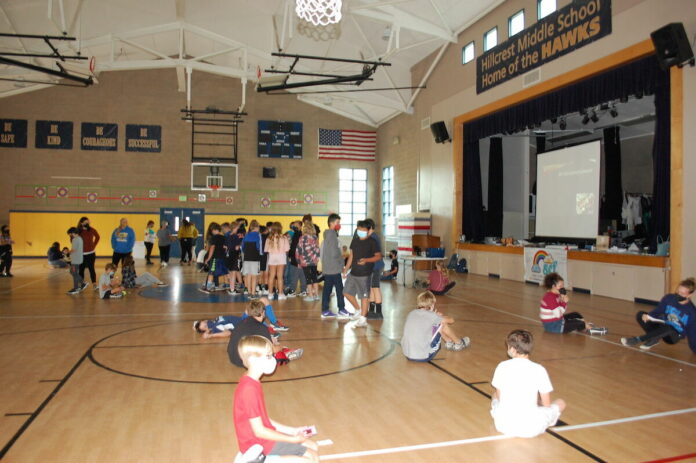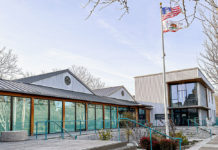
Sage Casey used “They, them, their” pronouns. SoCoNews will use “they, them, their” pronouns when referring to Casey.
On Monday afternoon, Sept. 27, a small group of students filed into the Hillcrest Middle School gym. Students sat cross legged and spaced apart on the wooden floor, glancing up at the projector screen and a banner hanging below that read, “The Sage Casey Foundation.”
The middle schoolers were gathering for the school’s first suicide prevention talk, a presentation and interactive exercise organized by Rebekah Schmitt of the Sage Casey Foundation, which was established after Schmitt lost her child Sage to suicide in 2017.
Sage Casey was a gender fluid, pansexual Sebastopol youth who attended Hillcrest Middle School.
On May 1, 2017, 14-year-old Sage Casey Schmitt committed suicide following a battle with depression after dealing with the pressure of wanting to be accepted — in the year before they committed suicide they came out to family and friends as gender fluid, meaning an individual without a fixed gender — according to the Sage Casey Foundation website. During that time, they also had changed their name to Sage Casey and wanted to be referred to with gender neutral pronouns.
The foundation’s mission is to bring awareness to suicide prevention, reduce the stigma surrounding conversations about mental health and provide positive support and encouragement to local youth by empowering them to pursue their passions.
The nonprofit also encourages youth to follow Sage’s example “by being a rainbow in someone else’s cloud.”
Schmitt told SoCoNews in 2018 that if there’s any good that can come from losing her child to suicide, it’s sharing Sage’s story to educate others about mental health.
And that’s exactly what Schmitt did on that muggy Monday in the middle school gym.
Schmitt discussed the importance of talking about mental health, resources for young students and how to get help, and how to recognize the warning signs of suicide.
“I want to share with you the resources and things that are available to you to help manage this (mental health) better, whether it is you struggling or friends struggling,” Schmitt told the group of students.
She admitted that it can be tough to talk about mental health, but it is important to have that conversation.
“Most people don’t want to die, but they just want their problems to be done with and they feel like they’ve become unmanageable and they don’t see a way out and a lot of that has to do with not getting some outside support,” Schmitt said. “If you are struggling or if you have a friend that’s struggling and you can reach out for outside support or a support that you can give you different resources, you’ll feel much better.”
She said most people at some point in their life will face some kind of crisis or hit a rock bottom and will have suicidal thoughts.
According to data from the 2019 National Survey on Drug Use and Health by the Substance Abuse and Mental Health Services Administration (SAMHSA), 4.8% of adults age 18 and older in the United States had serious thoughts about suicide in 2019.
In 2019, suicide was the second leading cause of death among individuals between the ages of 10 and 34, according to the Centers for Disease Control and Prevention Leading Causes of Death Reports.
“So if this is something you are struggling with, you are not alone,” Schmitt said.
She said nine out of 10 teens give warning signs before they attempt suicide.
Some suicide warning signs include changes in behavior such as increased use of alcohol or drugs, withdrawing from activities, isolating from family and friends, sleeping too much or too little, visiting or calling people to say goodbye, giving away possessions, looking for ways to end their lives, aggression and fatigue.
Schimitt said someone who may be giving warning signs may also be talking about killing themselves or feeling hopeless.
They also may say they’re a burden to others or that they wish they were never born, or that they’re feeling trapped.
At one point during the presentation, Schmitt handed out slips of paper with facts such as “Suicide is the tenth leading cause of death in the U.S. for all age” written on them.
Each student got a different fact and Schmitt told the group to read their fact to themselves and then share it with three other students.
Students also got to pick up a rainbow bag. The bag contains positive affirmations, a list of crisis resources, a colorful fidget spinner and other bright mementos like a rainbow pair of sunglasses.
The rainbow bag idea was created in the early days of the COVID-19 pandemic when it was difficult for the foundation to connect with people in person.
According to the Sage Casey Foundation website, the rainbow bags “are intended to bring a little bit of sunshine and care into someone’s day, bring a smile to their face, and remind them that they are not alone.”
The month of September marks Suicide Prevention and Awareness Month, and since COVID and distance learning brought with it both academic and mental health struggles, Hillcrest Principal William Deeths thought now was as good a time as ever to start a discussion about mental health.
“One thing we noticed throughout the course of distance learning was the fact that a lot of our students were facing mental health issues. I think they were seeing it in their own homes. This was a really good time for us to be able to offer this to our students,” Deeths said of the presentation.
Deeths said he’d like to have the foundation come every year to provide a presentation to students.
“It is important to make sure that the students always at least have this conversation started and to be able to have that knowledge,” he said.
In terms of other resources for students, Hillcrest currently has two full-time counselors. Students can meet with the counselors on a drop in basis or on a semi-regular regimen.
“We do our best to really offer our students that kind of support, especially at the middle school level. Having that person and a support that students can go to (is important), especially with the challenges they face such as going through puberty and going through all of the challenges of this age,” Deeths said.
Other resources
If you or someone you know is in crisis call 9-1-1 or the National Suicide Prevention Lifeline at 1-800-273-8255. The free, 24-hour hotline is available to anyone in suicidal crisis or emotional distress.
The North Bay Suicide Prevention Hotline is also another resource. The toll free 24-hour hotline can be reached at 855-587-6373.
For LGBTQIA+ youth support or for a young person who’s in crisis, suicidal, or needs someone to talk to in a safe judgment free zone, call the TrevorLifeline at 1-866-488-7386 or text START to 678678, or visit https://www.thetrevorproject.org/ to chat online.
The Sonoma County Department of Health Services also has a 24-hour crisis stabilization unit that provides 24 hour-a-day, 7 day-a-week crisis intervention, assessment, medication and up to 23 hours of supportive care for individuals in an acute mental health crisis.
Services are available for families, adults and children. The stabilization unit can be reached at 707-576-8181.







